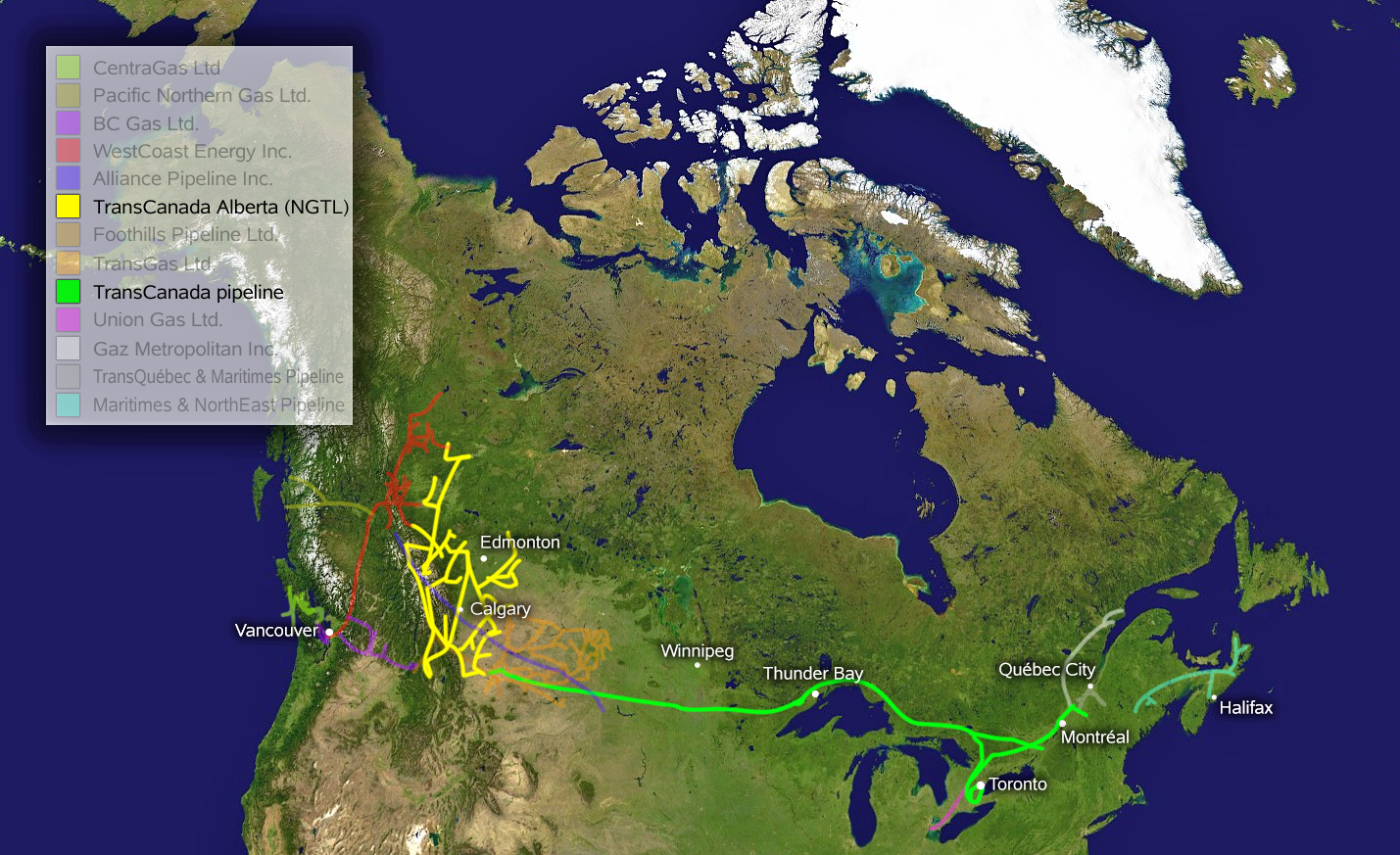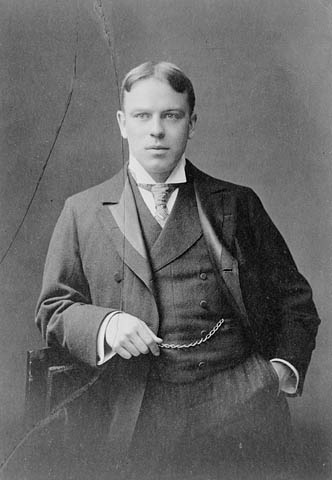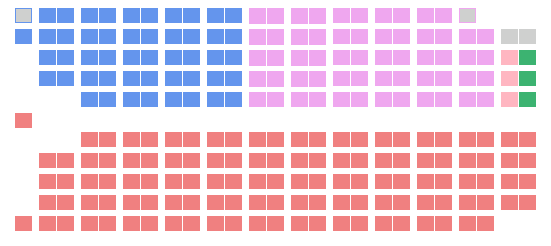|
Canadian Federal Election, 1957
The 1957 Canadian federal election was held June 10, 1957, to select the 265 members of the House of Commons of Canada of the 23rd Parliament of Canada. In one of the greatest upsets in Canadian political history, the Progressive Conservative Party (also known as "PCs" or "Tories"), led by John Diefenbaker, brought an end to 22 years of Liberal rule, as the Tories were able to form a minority government despite losing the popular vote to the Liberals. The Liberal Party had governed Canada since 1935, winning five consecutive elections. Under Prime Ministers William Lyon Mackenzie King and Louis St. Laurent, the government gradually built a welfare state. During the Liberals' fifth term in office, the opposition parties depicted them as arrogant and unresponsive to Canadians' needs. Controversial events, such as the 1956 "Pipeline Debate" over the construction of the Trans-Canada Pipeline, had hurt the government. St. Laurent, nicknamed "Uncle Louis", remained popular, but ex ... [...More Info...] [...Related Items...] OR: [Wikipedia] [Google] [Baidu] |
House Of Commons Of Canada
The House of Commons of Canada (french: Chambre des communes du Canada) is the lower house of the Parliament of Canada. Together with the Crown and the Senate of Canada, they comprise the bicameral legislature of Canada. The House of Commons is a democratically elected body whose members are known as members of Parliament (MPs). There have been 338 MPs since the most recent electoral district redistribution for the 2015 federal election, which saw the addition of 30 seats. Members are elected by simple plurality ("first-past-the-post" system) in each of the country's electoral districts, which are colloquially known as ''ridings''. MPs may hold office until Parliament is dissolved and serve for constitutionally limited terms of up to five years after an election. Historically, however, terms have ended before their expiry and the sitting government has typically dissolved parliament within four years of an election according to a long-standing convention. In any case, an ac ... [...More Info...] [...Related Items...] OR: [Wikipedia] [Google] [Baidu] |
Prime Minister Of Canada
The prime minister of Canada (french: premier ministre du Canada, link=no) is the head of government of Canada. Under the Westminster system, the prime minister governs with the Confidence and supply, confidence of a majority the elected House of Commons of Canada, House of Commons; as such, the prime minister typically sits as a Member of Parliament (Canada), member of Parliament (MP) and leads the largest party or a coalition of parties. As List of current Canadian first ministers, first minister, the prime minister selects ministers to form the Cabinet of Canada, Cabinet, and serves as its chair. Constitutionally, Government of Canada#Crown, the Crown exercises Executive (government), executive power on the Advice (constitutional law), advice of the Cabinet, which is collectively Responsible government, responsible to the House of Commons. Justin Trudeau is the List of prime ministers of Canada, 23rd and current prime minister of Canada. He took office on November 4, 2015 ... [...More Info...] [...Related Items...] OR: [Wikipedia] [Google] [Baidu] |
Quebec
Quebec ( ; )According to the Canadian government, ''Québec'' (with the acute accent) is the official name in Canadian French and ''Quebec'' (without the accent) is the province's official name in Canadian English is one of the thirteen provinces and territories of Canada. It is the largest province by area and the second-largest by population. Much of the population lives in urban areas along the St. Lawrence River, between the most populous city, Montreal, and the provincial capital, Quebec City. Quebec is the home of the Québécois nation. Located in Central Canada, the province shares land borders with Ontario to the west, Newfoundland and Labrador to the northeast, New Brunswick to the southeast, and a coastal border with Nunavut; in the south it borders Maine, New Hampshire, Vermont, and New York in the United States. Between 1534 and 1763, Quebec was called ''Canada'' and was the most developed colony in New France. Following the Seven Years' War, Quebec b ... [...More Info...] [...Related Items...] OR: [Wikipedia] [Google] [Baidu] |
Demonstration (political)
A political demonstration is an action by a mass group or collection of groups of people in favor of a political or other cause or people partaking in a protest against a cause of concern; it often consists of walking in a mass march formation and either beginning with or meeting at a designated endpoint, or rally, in order to hear speakers. It is different from mass meeting. Actions such as blockades and sit-ins may also be referred to as demonstrations. Demonstrations can be nonviolent or violent (usually referred to by participants as "Militant (word), militant"), or can begin as nonviolent and turn violent depending on the circumstances. Sometimes riot police or other forms of Law enforcement agency, law enforcement become involved. In some cases, this may be in order to try to prevent the protest from taking place at all. In other cases, it may be to prevent clashes between rival groups, or to prevent a demonstration from spreading and turning into a riot. History The t ... [...More Info...] [...Related Items...] OR: [Wikipedia] [Google] [Baidu] |
George A
George may refer to: People * George (given name) * George (surname) * George (singer), American-Canadian singer George Nozuka, known by the mononym George * George Washington, First President of the United States * George W. Bush, 43rd President of the United States * George H. W. Bush, 41st President of the United States * George V, King of Great Britain, Ireland, the British Dominions and Emperor of India from 1910-1936 * George VI, King of Great Britain, Ireland, the British Dominions and Emperor of India from 1936-1952 * Prince George of Wales * George Papagheorghe also known as Jorge / GEØRGE * George, stage name of Giorgio Moroder * George Harrison, an English musician and singer-songwriter Places South Africa * George, Western Cape ** George Airport United States * George, Iowa * George, Missouri * George, Washington * George County, Mississippi * George Air Force Base, a former U.S. Air Force base located in California Characters * George (Peppa Pig), a 2-year-old ... [...More Info...] [...Related Items...] OR: [Wikipedia] [Google] [Baidu] |
Cabinet Of Canada
The Cabinet of Canada (french: Cabinet du Canada) is a body of Minister of the Crown, ministers of the Crown that, along with the Canadian monarch, and within the tenets of the Westminster system, forms the government of Canada. Chaired by the Prime Minister of Canada, prime minister, the Cabinet (government), Cabinet is a committee of the King's Privy Council for Canada and the senior echelon of the Ministry (collective executive), Ministry, the membership of the Cabinet and ministry often being co-terminal; there were no members of the latter who were not also members of the former. For practical reasons, the Cabinet is informally referred to either in relation to the prime minister in charge of it or the number of ministries since Canadian Confederation, Confederation. The current cabinet is the Cabinet of Justin Trudeau, which is part of the 29th Canadian Ministry, 29th Ministry. The interchangeable use of the terms ''cabinet'' and '' ministry'' is a subtle inaccuracy that ... [...More Info...] [...Related Items...] OR: [Wikipedia] [Google] [Baidu] |
Trans-Canada Pipeline
The TransCanada pipeline is a system of natural gas pipelines, up to in diameter, that carries gas through Alberta, Saskatchewan, Manitoba, Ontario and Quebec. It is maintained by TransCanada PipeLines, LP. It is the longest pipeline in Canada. Creation Canada's population was booming during the 1950s, and energy shortages were becoming problematic. Canadian company TransCanada PipeLines Ltd. was incorporated in 1951 to undertake the construction of a natural gas pipeline across Canada. The financing of the project was split 50–50 between American and Canadian interests. Two applicants originally expressed interest in moving gas east: Canadian Delhi Oil Company (now called TCPL) proposed moving gas to the major cities of eastern Canada by an all-Canadian route, while Western Pipelines wanted to stop at Winnipeg with a branch line south to sell into the mid-western United States. In 1954 C. D. Howe, a member of the Cabinet of Canada of a Liberal Government, forced the two co ... [...More Info...] [...Related Items...] OR: [Wikipedia] [Google] [Baidu] |
Pipeline Debate
The Pipeline Debate (May 8 – June 6, 1956) was a political event in the history of the Parliament of Canada. The debate was on the finances of the TransCanada pipeline, proper parliamentary procedure, and American economic influence on Canada. The controversy eventually contributed to the defeat of Louis St. Laurent at the polls in 1957, ending 22 years of Liberal rule, and bringing in a government under Progressive Conservative Prime Minister John Diefenbaker. Background To meet the growing needs of Ontario and Quebec with the bountiful supply of natural gas in Alberta, St. Laurent and his Minister of Trade and Commerce, C. D. Howe, decided to allow TransCanada PipeLines, LP to build a gas pipeline from the west to the east. St. Laurent and Howe favoured a longer, more expensive route, entirely through Canadian territory, rejecting the route of the American oil pipeline, which was shorter but crossed into the United States on its way to Eastern Canada. The parliament ... [...More Info...] [...Related Items...] OR: [Wikipedia] [Google] [Baidu] |
Welfare State
A welfare state is a form of government in which the state (or a well-established network of social institutions) protects and promotes the economic and social well-being of its citizens, based upon the principles of equal opportunity, equitable distribution of wealth, and public responsibility for citizens unable to avail themselves of the minimal provisions for a good life. There is substantial variability in the form and trajectory of the welfare state across countries and regions. All welfare states entail some degree of private-public partnerships wherein the administration and delivery of at least some welfare programmes occurs through private entities. Welfare state services are also provided at varying territorial levels of government. Early features of the welfare state, such as public pensions and social insurance, developed from the 1880s onwards in industrializing Western countries. World War I, the Great Depression, and World War II have been characterized as impo ... [...More Info...] [...Related Items...] OR: [Wikipedia] [Google] [Baidu] |
William Lyon Mackenzie King
William Lyon Mackenzie King (December 17, 1874 – July 22, 1950) was a Canadian statesman and politician who served as the tenth prime minister of Canada for three non-consecutive terms from 1921 to 1926, 1926 to 1930, and 1935 to 1948. A Liberal, he was the dominant politician in Canada from the early 1920s to the late 1940s. King is best known for his leadership of Canada throughout the Great Depression and the Second World War. He played a major role in laying the foundations of the Canadian welfare state and established Canada's international reputation as a middle power fully committed to world order. With a total of 21 years and 154 days in office, he remains the longest-serving prime minister in Canadian history. Born in Berlin, Ontario (now Kitchener), King studied law and political economy in the 1890s and became concerned with issues of social welfare. He later obtained a PhD – the only Canadian prime minister to have done so. In 1900, he became deputy minister ... [...More Info...] [...Related Items...] OR: [Wikipedia] [Google] [Baidu] |
Federal Minority Governments In Canada
During the history of Canadian politics, thirteen minority governments have been elected at the federal level. There have also been two minority governments resulting from governments being replaced between elections, for a total of fifteen federal minority governments in thirteen separate minority parliaments. There have been historical cases where the governing party had fewer than half of the seats but had the support of independents who called themselves members of the party; these cases are not included, as there was never any serious chance of the government falling. In a minority situation, governments must rely on the support of other parties to stay in power, providing less stability than a majority government. At the federal level, no minority government (excepting the odd case of the 14th) has lasted a standard four-year term. Most minority governments have lasted less than two years. The average duration of completed minorities in Canada is 479 days or approximately ... [...More Info...] [...Related Items...] OR: [Wikipedia] [Google] [Baidu] |
Liberal Party Of Canada
The Liberal Party of Canada (french: Parti libéral du Canada, region=CA) is a federal political party in Canada. The party espouses the principles of liberalism,McCall, Christina; Stephen Clarkson"Liberal Party". ''The Canadian Encyclopedia''. and generally sits at the centre to centre-left of the Canadian political spectrum, with their rival, the Conservative Party, positioned to their right and the New Democratic Party, who at times aligned itself with the Liberals during minority governments, positioned to their left. The party is described as "big tent",PDF copy at UBC Press. practising "brokerage politics", attracting support from a broad spectrum of voters. The Liberal Party is the longest-serving and oldest active federal political party in the country, and has dominated federal |


.jpg)






